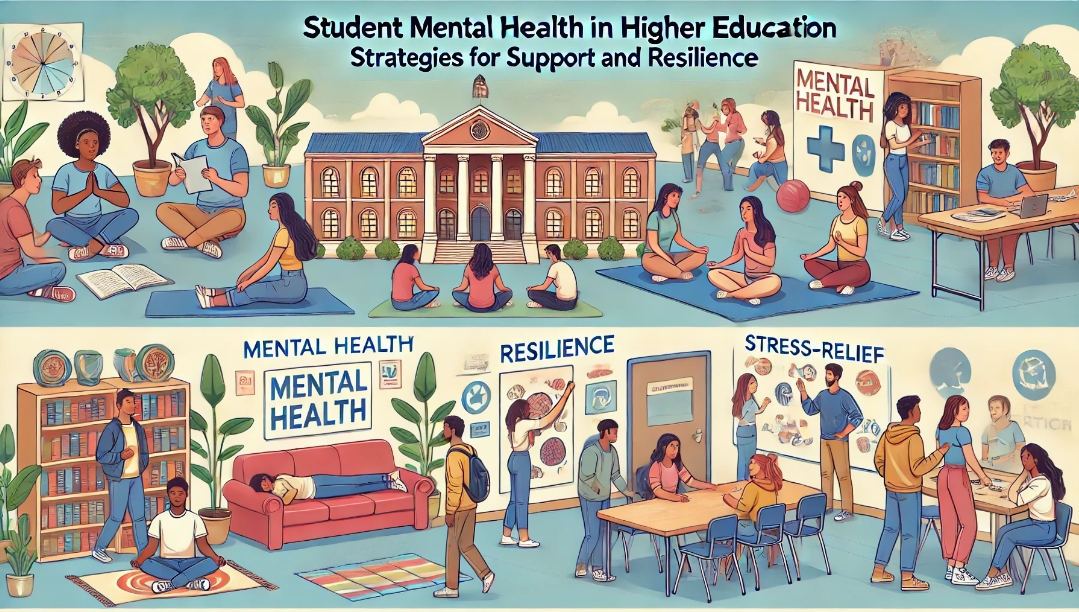Student Mental Health in Higher Education: Strategies for Support and Resilience

Mental health issues among college and university students have been on the rise, making student mental health a critical concern for higher education institutions. The pressures of academic performance, financial burdens, social dynamics, and the transition to adulthood contribute to stress, anxiety, depression, and other mental health challenges among students. With the growing awareness of the importance of mental health, universities are increasingly recognizing their role in supporting students’ well-being. Developing effective strategies to promote mental health, build resilience, and provide comprehensive support services is essential for helping students thrive academically, socially, and emotionally.
The Growing Mental Health Crisis in Higher Education
Recent studies have highlighted a troubling increase in mental health issues among college students. According to the American College Health Association, nearly 60% of students report feeling overwhelming anxiety, and over 40% struggle with depression during their college years. The COVID-19 pandemic has further exacerbated these issues, as students face increased isolation, uncertainty, and disruptions to their academic and personal lives.
Several factors contribute to this mental health crisis, including academic pressure, financial stress, social media influences, and the challenges of navigating new social environments. Additionally, many students are away from home for the first time, dealing with the complexities of managing their own lives without the support structures they are accustomed to. These pressures can lead to feelings of loneliness, burnout, and even thoughts of self-harm or suicide.
Key Strategies for Supporting Student Mental Health
1. Expanding Access to Mental Health Services
One of the most effective ways to support student mental health is by expanding access to mental health services on campus. This includes offering counseling services, mental health hotlines, and crisis intervention programs that are easily accessible to all students. Colleges should ensure that these services are well-publicized and available to students at no or low cost, removing financial barriers that might prevent students from seeking help.
Many universities are also integrating telehealth services, allowing students to access therapy and counseling from the comfort of their own homes. This approach can be particularly beneficial for students who may feel hesitant to visit a counseling center in person or who face scheduling conflicts that make in-person appointments difficult. By providing flexible, confidential support options, colleges can better meet the diverse needs of their student populations.
2. Promoting Mental Health Awareness and Education
Mental health education is crucial for reducing stigma and encouraging students to seek help when needed. Colleges can promote mental health awareness through workshops, seminars, and campaigns that educate students about common mental health issues, signs of distress, and available resources. Peer education programs, where trained students lead discussions and provide support to their peers, can also be highly effective in fostering a supportive campus culture.
Additionally, integrating mental health education into the academic curriculum can help normalize discussions about mental well-being. Courses that address stress management, mindfulness, and emotional intelligence can equip students with practical skills for managing their mental health and building resilience in the face of challenges.
3. Building Resilience Through Skill Development
Resilience—the ability to cope with adversity and bounce back from setbacks—is a key factor in maintaining mental health. Colleges can help students develop resilience by offering programs and workshops focused on skills such as problem-solving, time management, and emotional regulation. Teaching students how to manage stress, set realistic goals, and maintain a healthy work-life balance can empower them to handle the pressures of college life more effectively.
Mindfulness and meditation practices are also gaining popularity as tools for building resilience. Many universities now offer mindfulness programs, yoga classes, and meditation sessions to help students cultivate a sense of calm, reduce anxiety, and improve overall well-being. These practices encourage students to stay present, manage their emotions, and develop a greater sense of self-awareness, all of which contribute to resilience.
4. Creating a Supportive Campus Environment
A supportive campus environment plays a significant role in student mental health. Universities can foster a sense of community and belonging by creating inclusive, welcoming spaces where students feel safe and supported. This includes offering diverse student organizations, social events, and peer support networks that help students connect with others who share similar interests and experiences.
Housing and residential life programs can also play a crucial role in promoting mental well-being. Resident advisors (RAs) and residential staff can be trained to recognize signs of mental distress and provide support or referrals to appropriate services. Creating safe, inclusive residential spaces helps students feel more connected and supported, reducing feelings of isolation and loneliness.
5. Addressing Academic Pressures
Academic pressure is a significant source of stress for many students. To alleviate this burden, colleges can implement academic support services such as tutoring, academic advising, and workshops on study skills and time management. Flexible academic policies, such as allowing for mental health days, extensions on assignments, and pass/fail grading options, can also help reduce the pressure students feel to perform perfectly.
Faculty members play a key role in supporting student mental health by fostering a positive classroom environment and being attentive to signs of distress among their students. Professors can create open lines of communication, encourage students to seek help when needed, and incorporate mental health resources into their syllabi. By promoting a culture of empathy and understanding, faculty can contribute to a more supportive academic experience.
6. Providing Crisis Intervention and Emergency Support
Effective crisis intervention and emergency support services are essential for addressing severe mental health issues, such as suicidal ideation or acute anxiety attacks. Universities should have clear protocols in place for responding to mental health crises, including access to on-call counselors, emergency hotlines, and connections to local mental health facilities.
Training campus security, faculty, and staff in mental health first aid can also help ensure that students in crisis receive immediate and appropriate support. By being prepared to respond to emergencies, colleges can prevent crises from escalating and provide students with the care they need during critical moments.
Challenges in Supporting Student Mental Health
1. Stigma and Reluctance to Seek Help
Despite increased awareness of mental health issues, stigma remains a significant barrier to seeking help. Many students fear judgment or discrimination if they disclose their mental health struggles, which can prevent them from accessing the support they need. Colleges must work to reduce this stigma through awareness campaigns, supportive messaging, and visible endorsements of mental health services by campus leaders.
Creating an environment where seeking help is seen as a sign of strength, rather than weakness, is crucial for encouraging students to prioritize their mental health. Peer support networks and student-led initiatives can also help reduce stigma by normalizing conversations about mental well-being.
2. Limited Resources and Overburdened Services
Many universities face challenges in meeting the growing demand for mental health services. Counseling centers often experience long wait times, limited staffing, and budget constraints, making it difficult to provide timely care to all students. Expanding mental health services requires investment in additional counselors, mental health professionals, and alternative support options such as group therapy and peer support.
Colleges can also explore partnerships with community mental health providers to supplement on-campus services. Collaborating with local therapists, psychologists, and mental health organizations can help increase access to care and alleviate some of the burden on campus resources.
3. Addressing the Needs of Diverse Student Populations
Student populations are diverse, and mental health needs can vary significantly based on factors such as race, ethnicity, gender, sexual orientation, and socioeconomic status. Universities must take a culturally competent approach to mental health support, ensuring that services are inclusive and responsive to the unique needs of all students.
Providing training on cultural sensitivity for mental health staff, offering support groups for underrepresented students, and hiring counselors from diverse backgrounds can help create a more inclusive mental health care environment. Recognizing and addressing the specific challenges faced by marginalized students is essential for providing equitable mental health support.
The Future of Student Mental Health in Higher Education
The future of student mental health in higher education will likely involve a continued emphasis on holistic, proactive approaches to well-being. Technology will play an increasingly important role, with digital mental health tools, apps, and online support communities providing students with accessible resources at their fingertips. As universities adapt to meet the evolving needs of their students, the integration of mental health into all aspects of campus life will be crucial.
Furthermore, a growing focus on resilience and preventative care will help students build the skills they need to manage stress and navigate challenges. By prioritizing mental health, higher education institutions can create supportive, nurturing environments where students feel empowered to seek help, build resilience, and achieve their full potential.
Conclusion
Student mental health is a critical issue that requires the attention and commitment of higher education institutions. By expanding access to mental health services, promoting awareness, building resilience, and creating supportive campus environments, colleges and universities can better support their students’ mental well-being. Addressing the challenges of stigma, limited resources, and the diverse needs of the student population will be essential to these efforts.
Ultimately, investing in student mental health not only benefits individual students but also contributes to the overall success and vitality of the academic community. As institutions continue to innovate and adapt their support strategies, they have the opportunity to lead the way in fostering a culture of mental health and resilience that empowers students to thrive both during their college years and beyond.
